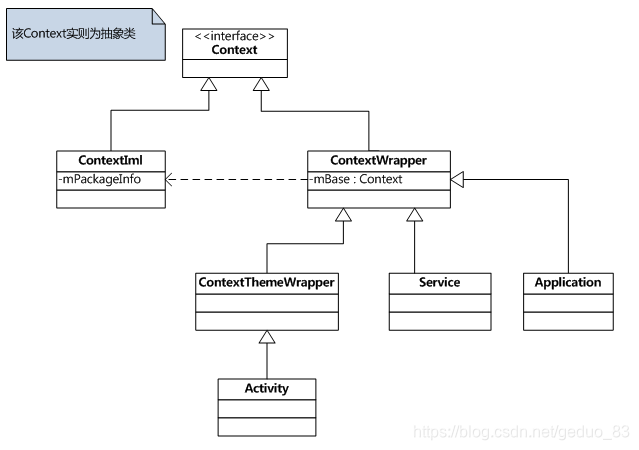1.Context是什么?
它描述的是一个应用程序环境的信息,即上下文,是维持各大组件能正常工作的一个核心功能类,该类是一个抽象类,提供了一些最基本的应用级别的操作

2. Context相关类的继承关系?

3.相关类介绍:
- 3.1 Context.java
路径: /frameworks/base/core/java/android/content/Context.java
说明: 抽象类,提供了一组通用的API,(打开一个Activity,开启关闭服务、绑定解绑服务、发送注册广播、获取服务、获取共享对象)
源代码:
public abstract class Context {
...
public abstract Object getSystemService(String name); //获得系统级服务
public abstract void startActivity(Intent intent); //通过一个Intent启动Activity
public abstract ComponentName startService(Intent service); //启动Service
//根据文件名得到SharedPreferences对象
public abstract SharedPreferences getSharedPreferences(String name,int mode);
...
} - 3.2 ContextIml.java类
路径 :/frameworks/base/core/java/android/app/ContextImpl.java
说明:该Context类的实现类为ContextIml,该类实现了Context类的功能。请注意,该函数的大部分功能都是直接调用,其 属性mPackageInfo去完成
源代码(部分)如下:
/**
* Common implementation of Context API, which provides the base
* context object for Activity and other application components.
*/
class ContextImpl extends Context{
//所有Application程序公用一个mPackageInfo对象
/*package*/ ActivityThread.PackageInfo mPackageInfo;
@Override
public Object getSystemService(String name){
...
else if (ACTIVITY_SERVICE.equals(name)) {
return getActivityManager();
}
else if (INPUT_METHOD_SERVICE.equals(name)) {
return InputMethodManager.getInstance(this);
}
}
@Override
public void startActivity(Intent intent) {
...
//开始启动一个Activity
mMainThread.getInstrumentation().execStartActivity(
getOuterContext(), mMainThread.getApplicationThread(), null, null, intent, -1);
}
} - 3.3 ContextWrapper类
路径 :\frameworks\base\core\java\android\content\ContextWrapper.java
说明: 正如其名称一样,该类只是对Context类的一种包装,该类的构造函数包含了一个真正的Context引用,即ContextIml对象
源代码:
public class ContextWrapper extends Context {
Context mBase; //该属性指向一个ContextIml实例,一般在创建Application、Service、Activity时赋值
//创建Application、Service、Activity,会调用该方法给mBase属性赋值
protected void attachBaseContext(Context base) {
if (mBase != null) {
throw new IllegalStateException("Base context already set");
}
mBase = base;
}
@Override
public void startActivity(Intent intent) {
mBase.startActivity(intent); //调用mBase实例方法
}
} - 3.4 ContextThemeWrapper.java
路径:/frameworks/base/core/java/android/view/ContextThemeWrapper.java
说明:该类内部包含了主题(Theme)相关的接口,即android:theme属性指定的。只有Activity需要主题,Service不需要主题,所以Service直接继承于ContextWrapper类。
源代码:
public class ContextThemeWrapper extends ContextWrapper {
//该属性指向一个ContextIml实例,一般在创建Application、Service、Activity时赋值
private Context mBase;
//mBase赋值方式同样有一下两种
public ContextThemeWrapper(Context base, int themeres) {
super(base);
mBase = base;
mThemeResource = themeres;
}
@Override
protected void attachBaseContext(Context newBase) {
super.attachBaseContext(newBase);
mBase = newBase;
}
} 4.什么时候创建Context实例
熟悉了Context的继承关系后,我们接下来分析应用程序在什么情况需要创建Context对象的?应用程序创建Context实例的
情况有如下几种情况:
- 4.1 创建Application 对象时, 而且整个App共一个Application对象
- 4.2 创建Service对象时
- 4.3 创建Activity对象时
因此应用程序App共有的Context数目公式为:
总Context实例个数 = Service个数 + Activity个数 + 1(Application对应的Context实例)
具体创建Context的时机
- a.创建Application对象的时机
每个应用程序在第一次启动时,都会首先创建Application对象。如果对应用程序启动一个Activity(startActivity)流程比较
清楚的话,创建Application的时机在创建handleBindApplication()方法中,该函数位于 ActivityThread.java类中 ,如下:
//创建Application时同时创建的ContextIml实例
private final void handleBindApplication(AppBindData data){ ...
///创建Application对象
Application app = data.info.makeApplication(data.restrictedBackupMode, null);
...
}
public Application makeApplication(boolean forceDefaultAppClass, Instrumentation instrumentation) { ...
try {
java.lang.ClassLoader cl = getClassLoader();
ContextImpl appContext = new ContextImpl(); //创建一个ContextImpl对象实例
appContext.init(this, null, mActivityThread); //初始化该ContextIml实例的相关属性
///新建一个Application对象
app = mActivityThread.mInstrumentation.newApplication(
cl, appClass, appContext);
appContext.setOuterContext(app); //将该Application实例传递给该ContextImpl实例
}
...
} - b. 创建Activity对象的时机
通过startActivity()或startActivityForResult()请求启动一个Activity时,如果系统检测需要新建一个Activity对象时,就会回调handleLaunchActivity()方法,该方法继而调用performLaunchActivity()方法,去创建一个Activity实例,并且回调 onCreate(),onStart()方法等, 函数都位于ActivityThread.java类 ,如下:
//创建一个Activity实例时同时创建ContextIml实例
private final void handleLaunchActivity(ActivityRecord r, Intent customIntent) {
...
Activity a = performLaunchActivity(r, customIntent); //启动一个Activity
}
private final Activity performLaunchActivity(ActivityRecord r, Intent customIntent) {
...
Activity activity = null;
try {
//创建一个Activity对象实例
java.lang.ClassLoader cl = r.packageInfo.getClassLoader();
activity = mInstrumentation.newActivity(cl, component.getClassName(), r.intent);
}
if (activity != null) {
ContextImpl appContext = new ContextImpl(); //创建一个Activity实例
appContext.init(r.packageInfo, r.token, this); //初始化该ContextIml实例的相关属性
appContext.setOuterContext(activity); //将该Activity信息传递给该ContextImpl实例
...
}
...
} - c. 创建Service对象的时机
通过startService或者bindService时,如果系统检测到需要新创建一个Service实例,就会回调handleCreateService()方法,
完成相关数据操作。handleCreateService()函数位于 ActivityThread.java类,如下:
[java] view plain copy print?
//创建一个Service实例时同时创建ContextIml实例
private final void handleCreateService(CreateServiceData data){
...
//创建一个Service实例
Service service = null;
try {
java.lang.ClassLoader cl = packageInfo.getClassLoader();
service = (Service) cl.loadClass(data.info.name).newInstance();
} catch (Exception e) {
}
...
ContextImpl context = new ContextImpl(); //创建一个ContextImpl对象实例
context.init(packageInfo, null, this); //初始化该ContextIml实例的相关属性
//获得我们之前创建的Application对象信息
Application app = packageInfo.makeApplication(false, mInstrumentation);
//将该Service信息传递给该ContextImpl实例
context.setOuterContext(service);
...
} 另外,需要强调一点的是,通过对ContextImp的分析可知,其方法的大多数操作都是直接调用其属性mPackageInfo(该属性类型为PackageInfo)的相关方法而来。这说明ContextImp是一种轻量级类,而PackageInfo才是真正重量级的类。而一个App里的所有ContextIml实例,都对应同一个packageInfo对象。
5.getBaseContext、getApplicationContext、getAppliction的区别?
getAppliction:获取Application对象,是Activity、Service的方法
getApplicationContext : 获取app上下文环境,
getBaseContext:获取ContextImpl实现类
6.最后给大家分析利用Context获取SharedPreferences类的使用方法
SharedPreferences类想必大家都使用过,其一般获取方法就是通过调用getSharedPreferences()方法去根据相关信息获取SharedPreferences对象。具体流程如下:
- 6.1 调用 getSharedPreferences()获取对应的的文件,该函数实现功能如下:
//Context类静态数据集合,以键值对保存了所有读取该xml文件后所形成的数据集合
private static final HashMap<File, SharedPreferencesImpl> sSharedPrefs =
new HashMap<File, SharedPreferencesImpl>();
@Override
public SharedPreferences getSharedPreferences(String name, int mode){
//其所对应的SharedPreferencesImpl对象 ,该对象已一个HashMap集合保存了我们对该文件序列化结果
SharedPreferencesImpl sp;
File f = getSharedPrefsFile(name); //该包下是否存在对应的文件,不存在就新建一个
synchronized (sSharedPrefs) { //是否已经读取过该文件,是就直接返回该SharedPreferences对象
sp = sSharedPrefs.get(f);
if (sp != null && !sp.hasFileChanged()) {
//Log.i(TAG, "Returning existing prefs " + name + ": " + sp);
return sp;
}
}
//以下为序列化该xml文件,同时将数据写到map集合中
Map map = null;
if (f.exists() && f.canRead()) {
try {
str = new FileInputStream(f);
map = XmlUtils.readMapXml(str);
str.close();
}
...
}
synchronized (sSharedPrefs) {
if (sp != null) {
//Log.i(TAG, "Updating existing prefs " + name + " " + sp + ": " + map);
sp.replace(map); //更新数据集合
} else {
sp = sSharedPrefs.get(f);
if (sp == null) {
//新建一个SharedPreferencesImpl对象,并且设置其相关属性
sp = new SharedPreferencesImpl(f, mode, map);
sSharedPrefs.put(f, sp);
}
}
return sp;
}
} 6.2 SharedPreferences 不过是个接口,它定义了一些操作xml文件的方法,其真正实现类为SharedPreferencesImpl ,该类是ContextIml的内部类,该类如下:
//soga,这种形式我们在分析Context ContextIml时接触过
//SharedPreferences只是一种接口,其真正实现类是SharedPreferencesImpl类
private static final class SharedPreferencesImpl implements SharedPreferences{
private Map mMap; //保存了该文件序列化结果后的操作, 键值对形式
//通过key值获取对应的value值
public String getString(String key, String defValue) {
synchronized (this) {
String v = (String)mMap.get(key);
return v != null ? v : defValue;
}
}
...
//获得该SharedPreferencesImpl对象对应的Edito类,对数据进行操作
public final class EditorImpl implements Editor {
private final Map<String, Object> mModified = Maps.new HashMap(); //保存了对键值变化的集合
}
} 架构分析:
- SharedPreferences:定义了一个操作数据文件的接口用来读数据,里面还包含了一个内部接口Editor专门用来进行写数据,从而实现读写分离
- SharedPreferencesImpl:它是SharedPreferences的实现类,它不但实现了SharedPreferences的读数据接口,而且还实现了其内部接口Editor的写接口
- File:具体的数据存储实体
- ContextImpl:暴露了获取SharedPreferences的接口,其本质是维护了一个ArrayMap用来缓存 ,SharedPreferences和其对应的File
体现的设计模式:
- 模板方法
- 享元模式
- 建造者模式